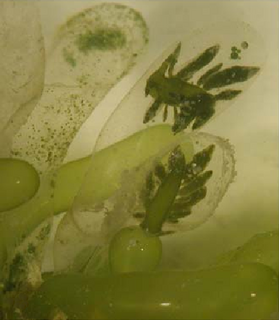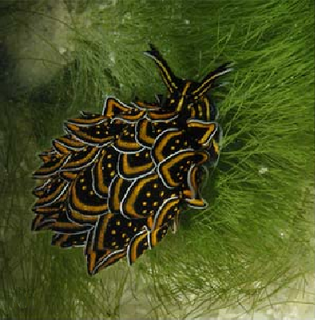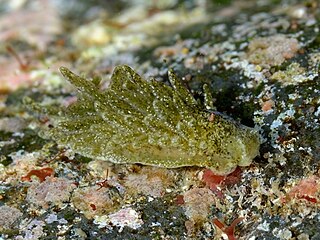
Sacoglossa, commonly known as the sacoglossans or the "sap-sucking sea slugs", are a clade of small sea slugs and sea snails, marine gastropod mollusks that belong to the clade Heterobranchia. Sacoglossans live by ingesting the cellular contents of algae, hence the adjective "sap-sucking".

Caulerpa taxifolia is a species of seaweed, an alga of the genus Caulerpa native to the Pacific Ocean and Caribbean Sea. It is widely used ornamentally in aquariums, because it is considered attractive and neat in arrangement, and is easy to establish and care for. The alga has a stem (rhizome) just above the seafloor. From this stem grow vertical fern-like pinnae, whose blades are flat like those of the yew (Taxus), hence the species name taxifolia.

Kleptoplasty or kleptoplastidy is a symbiotic phenomenon whereby plastids, notably chloroplasts from algae, are sequestered by host organisms. The word is derived from Kleptes (κλέπτης) which is Greek for thief. The alga is eaten normally and partially digested, leaving the plastid intact. The plastids are maintained within the host, temporarily continuing photosynthesis and benefiting the predator. The term was coined in 1990 to describe chloroplast symbiosis.

Elysia chlorotica is a small-to-medium-sized species of green sea slug, a marine opisthobranch gastropod mollusc. This sea slug superficially resembles a nudibranch, yet it does not belong to that clade of gastropods. Instead it is a member of the clade Sacoglossa, the sap-sucking sea slugs. Some members of this group use chloroplasts from the algae they eat for photosynthesis, a phenomenon known as kleptoplasty. Elysia chlorotica is one of these "solar-powered sea slugs". It lives in a subcellular endosymbiotic relationship with chloroplasts of the marine heterokont alga Vaucheria litorea.

Limapontiidae is a taxonomic family of small to minute sacoglossan sea slugs. These are marine opisthobranch gastropod mollusks.

Elysia is a genus of sea slugs, marine gastropod molluscs in the family Plakobranchidae. These animals are colorful sea slugs, and they can superficially resemble nudibranchs, but are not very closely related to them. Instead they are sacoglossans, commonly known as sap-sucking slugs.

Juliidae, common name the bivalved gastropods, is a family of minute sea snails, marine gastropod mollusks or micromollusks in the superfamily Oxynooidea, an opisthobranch group. These are sacoglossan (sap-sucking) sea snails, and many of them are green in color.

Nudipleura are a clade of sea snails and sea slugs, marine gastropod mollusks within the large clade Heterobranchia.

Limapontioidea are a superseded superfamily of sea slugs, marine gastropod mollusks within the superorder Sacoglossa.

Bosellia is a genus of sea slugs, marine gastropod mollusks within the superfamily Plakobranchoidea.
Platyhedylidae is a family of sacoglossan sea slugs, marine gastropod mollusks in the superfamily Platyhedylidae.

Caliphyllidae is a taxonomic family of sacoglossan sea slugs. These are marine opisthobranch gastropod mollusks in the clade Sacoglossa.

Costasiella kuroshimae, also known as a "leaf slug" or "leaf sheep", or "salty ocean caterpillar" is a species of sacoglossan sea slug. Costasiella kuroshimae are shell-less marine opisthobranch gastropod mollusks in the family Costasiellidae. They range in size from 5 millimetres (0.20 in) to 1 centimetre (0.39 in) in length.

Ercolania is a genus of small sacoglossan sea slugs, shell-less marine opisthobranch gastropod mollusks in the family Limapontiidae.
Ercolania irregularis is a species of sacoglossan sea slug, a shelless marine opisthobranch gastropod mollusk in the family Limapontiidae.
Ercolania tentaculata is a species of sacoglossan sea slug, a shell-less marine opisthobranch gastropod mollusk in the family Limapontiidae.
Ercolania varians is a species of sacoglossan sea slug, a shell-less marine opisthobranch gastropod mollusk in the family Limapontiidae.
Ercolania zanzibarica is a species of sacoglossan sea slug, a shell-less marine opisthobranch gastropod mollusk in the family Limapontiidae.

Acetabularia acetabulum is a species of green alga in the family Polyphysaceae. It is found in the Mediterranean Sea at a depth of one to two metres.

Alderia modesta is a species of sea slug, a marine gastropod mollusc in the family Limapontiidae. It is found in estuarine habitats and saltmarshes on either side of the North Atlantic and the North Pacific Oceans.












